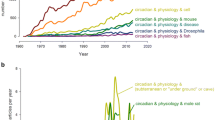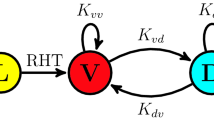Abstract
The circadian pacemaker of mammals comprises multiple oscillators that may adopt different phase relationships to determine properties of the coupled system. The effect of nocturnal illumination comparable to dim moonlight was assessed in male Siberian hamsters exposed to two re-entrainment paradigms believed to require changes in the phase relationship of underlying component oscillators. In experiment 1, hamsters were exposed to a 24-h light-dark-light-dark cycle previously shown to split circadian rhythms into two components such that activity is divided between the two daily dark periods. Hamsters exposed to dim illumination (<0.020 lx) during each scotophase were more likely to exhibit split rhythms compared to hamsters exposed to completely dark scotophases. In experiment 2, hamsters were transferred to winter photoperiods (10 h light, 14 h dark) from two different longer daylengths (14 h or 18 h light daily) in the presence or absence of dim nighttime lighting. Dim nocturnal illumination markedly accelerated adoption of the winter phenotype as reflected in the expansion of activity duration, gonadal regression and weight loss. The two experiments demonstrate substantial efficacy of light intensities generally viewed as below the threshold of circadian systems. Light may act on oscillator coupling through rod-dependent mechanisms.






Similar content being viewed by others
Abbreviations
- α:
-
activity duration
- DD:
-
constant dark or dim
- E:
-
evening oscillator
- ETV:
-
estimated testis volume
- LDLD:
-
light-dark-light-dark cycle
- LED:
-
light emitting diode
- M:
-
morning oscillator
- SCN:
-
suprachiasmatic nuclei
- τ:
-
free-running period
References
Aschoff J (1960) Exogenous and endogenous components in circadian rhythms. Cold Spring Harbor Symp Quant Biol 25:11-28
Berson DM (2003) Strange vision: ganglion cells as circadian photoreceptors. Trends Neurosci 26:314-320
Daan S, Aschoff J (1975) Circadian rhythms of locomotor activity in captive birds and mammals: their variations with season and latitude. Oecologia 18:269-316
Daan S, Berde C (1978) Two coupled oscillators: simulations of the circadian pacemaker in mammalian activity rhythms. J Theor Biol 70:297-313
Elliott JA, Tamarkin L (1994) Complex circadian regulation of pineal melatonin and wheel-running in Syrian hamsters. J Comp Physiol A 174:469-484
Erkert HG (1976) Light-induced activity optimum in night monkeys (Aotus trivirgatus). Folia Primatol 25:186-192
Erkert HG, Grober J (1986) Direct modulation of activity and body temperature of owl monkeys (Aotus lemurinus griseimembra) by low light intensities. Folia Primatol 47:171-188
Erkert HG, Bay FA, Kracht S (1976) Zeitgeber induced modulation of activity patterns in nocturnal mammals (Chiroptera). Experientia 32:560-562
Evans JA, Gorman MR (2002) Split circadian rhythms of female Syrian hamsters and their offspring. Physiol Behav 76:469-478
Ferraro JS (1990) Nocturnal illumination maintains reproductive function and simulates the period-lengthening effect of constant light in the mature male Djungarian hamster (Phodopus sungorus). J Interdiscipl Cycle Res 21:1-16
Ferraro JS, McCormack CE (1984) Nature of the light stimulus producing Aschoff’s intensity effect and anovulation. Am J Physiol 247:R296-R301
Freedman MS, Lucas RJ, Soni B, Schantz M von, Munoz M, David-Gray Z, Foster R (1999) Regulation of mammalian circadian behavior by non-rod, non-cone, ocular photoreceptors. Science 284:502-504
Freeman DA, Goldman BD (1997) Evidence that the circadian system mediates photoperiodic nonresponsiveness in Siberian hamsters. J Biol Rhythms 12:100-109
Goldman BD (2001) Mammalian photoperiodic system: formal properties and neuroendocrine mechanisms of photoperiodic time measurement. J Biol Rhythms 16:283-301
Goldman SL, Goldman BD (2003) Early photoperiod history and short-day responsiveness in Siberian hamsters. J Exp Zool A 296:38-45
Gorman MR (2001) Exotic photoperiods induce and entrain split circadian activity rhythms in hamsters. J Comp Physiol A 187:793-800
Gorman MR, Elliott JA (2003) Entrainment of two subjective nights by light:dark:light:dark cycles in three rodent species. J Biol Rhythms 18:502-512
Gorman MR, Lee TM (2001) Daily novel wheel running reorganizes and splits hamster circadian activity rhythms. J Biol Rhythms 16:541-551
Gorman MR, Zucker I (1997) Environmental induction of photononresponsiveness in the Siberian hamster, Phodopus sungorus. Am J Physiol 272:R887-R895
Gorman MR, Freeman DA, Zucker I (1997) Photoperiodism in hamsters: abrupt versus gradual changes in day length differentially entrain morning and evening circadian oscillators. J Biol Rhythms 12:122-135
Gorman MR, Elliott JA, Evans JA (2003) Plasticity of hamster circadian entrainment patterns depends on light intensity. Chronobiol Int 20:233-248
Hattar S, Liao HW, Takao M, Berson DM, Yau KW (2002) Melanopsin-containing retinal ganglion cells: architecture, projections, and intrinsic photosensitivity. Science 295:1065-1070
Hoffmann K, Illnerova H, Vanecek J (1986) Change in duration of the nighttime melatonin peak may be a signal driving photoperiodic response in the Djungarian hamster (Phodopus sungorus). Neurosci Lett 67:68-72
Illnerova H (1991) The suprachiasmatic nucleus and rhythmic pineal melatonin production. In: Klein DC, Moore RY, Reppert SM (eds) Suprachiasmatic nucleus: the mind’s clock. Oxford University Press, New York, pp 197-216
Illnerova H, Hoffmann K, Vanecek J (1986) Adjustment of the rat pineal N-acetyltransferase rhythm to change from long to short photoperiod depends on the direction of the extension of the dark period. Brain Res 362:403-408
Kavanau JL (1967) Behaviour of captive white-footed mice. Science 155:1623-1639
Kliman RM, Lynch GR (1992) Evidence for genetic variation in the occurrence of the photoresponse of the Djungarian hamster, Phodopus sungorus. J Biol Rhythms 7:161-175
Kunz H, Achermann P (2003) Simulation of circadian rhythm generation in the suprachiasmatic nucleus with locally coupled self-sustained oscillators. J Theor Biol 224:63-78
Meijer JH, Daan S, Overkamp GJ, Hermann PM (1990) The two-oscillator circadian system of tree shrews (Tupaia belangeri) and its response to light and dark pulses. J Biol Rhythms 5:1-16
Mrosovsky N (1999) Masking: history, definitions, and measurement. Chronobiol Int 16:415-429
Mrosovsky N, Janik DS (1993) Behavioral decoupling of circadian rhythms. J Biol Rhythms 8:57-65
Oda GA, Menaker M, Friesen WO (2000) Modeling the dual pacemaker system of the tau mutant hamster. J Biol Rhythms 15:246-264
Panda S, Sato TK, Castrucci AM, Rollag MD, DeGrip WJ, Hogenesch JB, Provencio I, Kay SA (2002) Melanopsin (Opn4) requirement for normal light-induced circadian phase shifting. Science 298:2213-2216
Pittendrigh CS (1974) Circadian oscillations in cells and the circadian organization of multicellular systems. In: Schmitt FO, Worden FG (eds) The neurosciences. Third study program. MIT Press, Cambridge, pp 437-458
Pittendrigh CS, Daan S (1976) A functional analysis of circadian pacemakers in nocturnal rodents. V. Pacemaker structure: a clock for all seasons. J Comp Physiol A 106:333-355
Pittendrigh CS, Elliott JA, Takamura T (1984) The circadian component in photoperiodic induction. CIBA Foundation Symposium 104:26-47
Prendergast BJ, Freeman DA (1999) Pineal-independent regulation of photo-nonresponsiveness in the Siberian hamster (Phodopus sungorus). J Biol Rhythms 14:62-71
Puchalski W, Lynch GR (1986) Evidence for differences in the circadian organization of hamsters exposed to short day photoperiod. J Comp Physiol A 159:7-11
Puchalski W, Lynch GR (1988) Characterization of circadian function in Djungarian hamsters insensitive to short-day photoperiod. J Comp Physiol A 162:309-316
Ruby NF, Brennan TJ, Xie X, Cao V, Franken P, Heller HC, O’Hara BF (2002) Role of melanopsin in circadian responses to light. Science 298:2211-2213
Sumova A, Travnickova Z, Illnerova H (1995) Memory on long but not on short days is stored in the rat suprachiasmatic nucleus. Neurosci Lett 200:191-194
Acknowledgements
We are grateful to Antonio Mora and Tony Mora for excellent animal care, and to Magdalena Kendall and Mona Fallah-Tafti for assistance with analysis. This research was supported by NIH grants HD-36460 and NS-30235 and NSF grant IBN-0346391 and was conducted in compliance with all rules and regulations of the Animal Care and Use Committee, University of California, San Diego and the USDA, and followed recommendations in Guide for the Care and Use of Laboratory Animals.
Author information
Authors and Affiliations
Corresponding author
Rights and permissions
About this article
Cite this article
Gorman, M.R., Elliott, J.A. Dim nocturnal illumination alters coupling of circadian pacemakers in Siberian hamsters, Phodopus sungorus . J Comp Physiol A 190, 631–639 (2004). https://doi.org/10.1007/s00359-004-0522-7
Received:
Revised:
Accepted:
Published:
Issue Date:
DOI: https://doi.org/10.1007/s00359-004-0522-7




